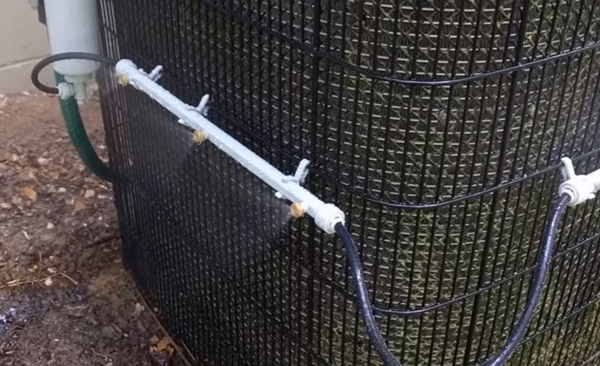
It’s July in southern Indiana which means it’s hot and humid outside. But this year it’s worse because there’s a heat dome over us and while both we and the corn in the fields are sweating, air conditioning units are working overtime to keep our homes cool and comfortable. AC units use a lot of electricity which can lead to dread when the electric company bills show up in the mailbox. Is there anything you can do to make your AC run less while still keeping your house cool? Mistbox is a gadget that has been designed to help you save up to 30%, depending on where you live, on your monthly electric bill during the hot summer months. Let’s take a look.
What is it?
Mistbox is a device that connects to your outdoor AC condenser unit and sprays a fine water mist around it while it is running. The mist pre-cools the air around the AC, which helps it be more efficient and the air coming out of your registers will be a few degrees colder than without the Mistbox. Here’s a video that does a good job of explaining the process:
What’s in the box?
Mistbox main unit with attached filter
AC charging adapter with interchangeable plugs
Mist sprayer bars
Attachment hardware
User guide
Design and features
The Mistbox system consists of a plastic control unit, a sprayer arm assembly and an app. The control unit has an LCD display with three buttons, a WiFi antenna, water filter and a water intake connector.
On the back of the unit is a power port that can be used to charge the controller’s battery.
The Mistbox controller also has a solar panel on top which will keep the battery charged if your AC unit is in a location that receives a few hours of sunlight each day. Mistbox sells an auxiliary solar panel can be added to the unit by plugging it into the power jack on the back of the controller.
Setup and installation
Installing the Mistbox is pretty painless if your AC unit is located next to a water spigot and gets a signal from your home wireless network. The unit comes with everything you need for the installation except for a hose that connects from the water spigot to the connector on the Mistbox. I happened to have a very short section of hose from an old hose reel that worked perfectly for this application, but you can use a regular length hose just as well.
To install the Mistbox, you first attach the controller to a corner of your AC unit. You can do this with screws or with zip ties. I used zip ties.
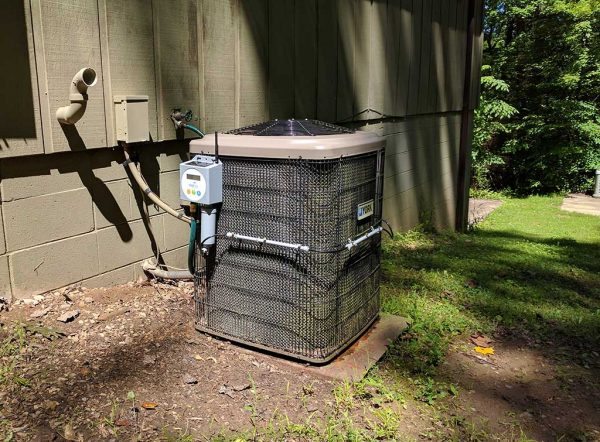
One end of the sprayer bar assembly attaches to the bottom of the filter on the control unit and then using the included clips or zip ties you can attach the sprayer arms to the sides of the AC unit so that the spray nozzles are all pointing away from the air conditioning unit. The four sprayer arms are connected with a thin hose that can be pushed into the arms to adjust the length.
The installation process took me only about 20 minutes or so to complete, so it’s really easy. I spent more time looking for a hose than actually attaching the hardware to my AC unit.
The final step in setting up the Mistbox requires that you install the Mistbox app on your Android or iOS device. The app will walk you through the steps of setting up the control unit to connect to your home’s wireless network. I had a little trouble with this step, but after a couple of tries, I was up and running.
The app is easy to use and shows the current status of the unit, last time it was updated, and the local temperature. Dragging up on the picture of the AC unit will let you scroll through a timeline that shows how long your AC unit was running at different times during the day.
The app has a status screen like the one you see above on the left. This screen shows the current status of the unit along with info on the battery level, filter and water saving mode status.
The settings screen will let you toggle the misting option on/off, water saver mode on/off and set the misting temperature trigger (75 – 90°F).
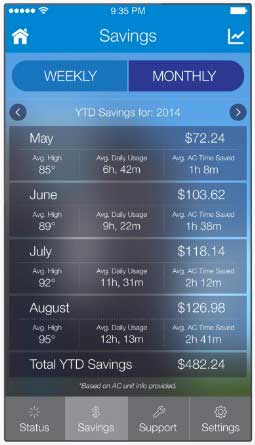
The savings screen takes several weeks before it starts showing info. The info is based on the information that you submit during the setup process about your power company and the price per kWh. I’ve been using the Mistbox for a couple of weeks and still don’t have any savings info, but I’ve added the image above as an example of what I should be seeing after about a month of use.
Does Mistbox work as advertised?
During the time that I’ve been using Mistbox, I’ve noticed that my AC unit has been running less than before I installed it. I’ve used my Nest thermostat app data to compare how much time my AC unit runs on days using the Mistbox with days when the Mistbox has been disabled. My testing hasn’t been very scientific since there are a lot of factors that can change how much the AC runs like temperature, humidity, wind, which are not identical every day. But I tried comparing similar days as best as I could and found that my AC was running an hour or so less on the days that the Mistbox was enabled. Again, I can’t really promise that you will have the same results. Depending on where you live you could have better or worse results.
In addition to the AC not running quite as much on days with the Mistbox enabled, I noticed that the air coming out of my registers was noticeably colder whenever the Mistbox was misting. In the beginning, I thought it was my imagination, so I got out my handy dandy IR thermometer and pointed it down one of the registers in my floor. With the AC and Mistbox running, the air was 3-4 degrees cooler than when the AC was running without the Mistbox.
Concerns
We all know that air conditioning units are exposed to the elements / weather day in and day out, 365 days of the year. But the biggest concern for some people is the potential for calcium build up or rust due to increased water exposure from misting. When I asked about these concerns, Mistbox agreed that while untreated water could indeed cause such issues, their product comes with a high-quality filter which guards against corrosion. The filter must be replaced annually ($29.99) and is rated for any municipal water supply that follows EPA guidelines, which is a maximum hardness of 500 PPM (parts per million) of dissolved solids. Mistbox does not recommend using their product with well water or with water that has a hardness level above 500 PPM. If your water is above that hardness level, they recommend using a secondary filtration system.
See it in action
Mistbox uses sound and electro-magnetic field to detect when the AC unit turns on so it can start misting. If the outdoor temperature is at or above the set trigger temperature in the app, misting will start. The unit doesn’t mist the whole time the AC is running, but cycles on and off. I wondered about water usage, so I bought a cheap water meter from Amazon that I placed between the water coming out of my spigot and the Mistbox control unit. Unfortunately, the battery in the meter died after collecting info for a week, so I lost all that data. I contacted Mistbox to ask about water usage and this is what they told me:
Mistbox is misting is 0.12 gal/min or 7.2 gal/hr. It equates to pennies a day in water consumption even in places with expensive water.
Water saver mode just makes Mistbox cycle the misting off more regularly during longer AC cycles. It uses about a third less water in water saver mode while still producing about 80% of the benefit.
Water usage is the main thing about the Mistbox that I don’t like. But it’s not the price of water that bothers me, it’s all the water that ends up on the ground. I live in the woods, so my yard is mostly sticks, rocks, leaves and weeds with a little grass. The area around my AC unit is mostly bare ground. Even with the water saver mode turned on, the area around my AC unit remained wet and kind of muddy. Since the AC unit is located next to a wall of my walkout basement, it makes me nervous that all the water will somehow seep through the wall and might eventually cause a moisture or mold problem.
Final thoughts
Mistbox says it can cut your energy bills during the hot summer months by as much as 30%. That promise comes with a few conditions that have to be met. In order to earn the most savings, you need to live in a dry location. Humid locations like mine will still see improvement using the Mistbox, but not as much as other areas. And of course, you need hot weather for the AC to run.
Saving money and using electricity more efficiently is something we should all be concerned with. I believe that the Mistbox can positively impact your energy usage and the effectiveness of your AC unit. If I were ambitious enough to put gravel or some other type of drainage around my outdoor AC unit, I’d leave the Mistbox hooked up all summer, but for me, the wet ground around my AC keeps me from wanting to do that.
Source: The sample for this review was provided by Mistbox. Please visit their site for more info and Amazon to price check / order.
INIU Mini Portable Charger, Small 45W PD Power Bank, 10000mAh USB C in&Out Fast Charging Pocket Size Battery Pack, Travel Essentials Powerbank for iPhone 17 16 15 14 Pro Air, Xiaomi, Samsung S24 etc
32% OffINIU Portable Charger, Smallest 22.5W 10000mAh Power Bank, USB C in/Output Fast Charging 3-Output Mini Battery Pack Charger with Phone Holder for iPhone 17 16 15 14 Air Samsung S23 Google iPad Tablet
26% OffProduct Information
| Price: | $399.00 |
| Manufacturer: | Mistbox |
| Retailer: | Amazon |
| Requirements: |
|
| Pros: |
|
| Cons: |
|

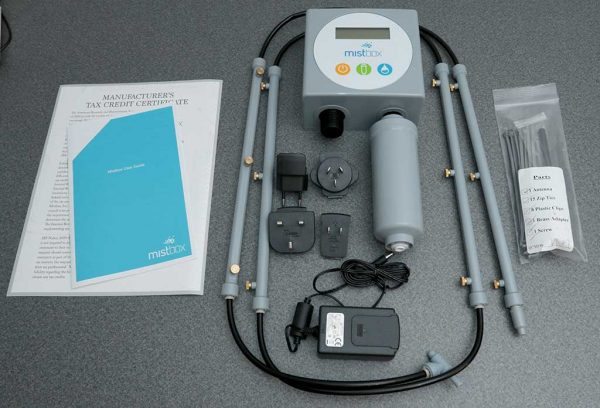
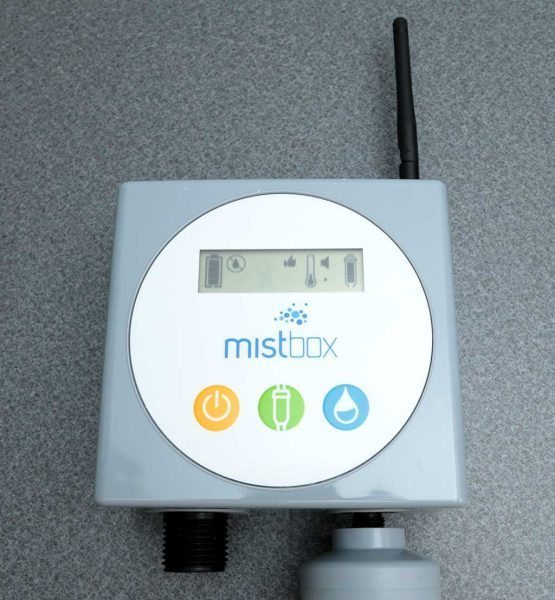
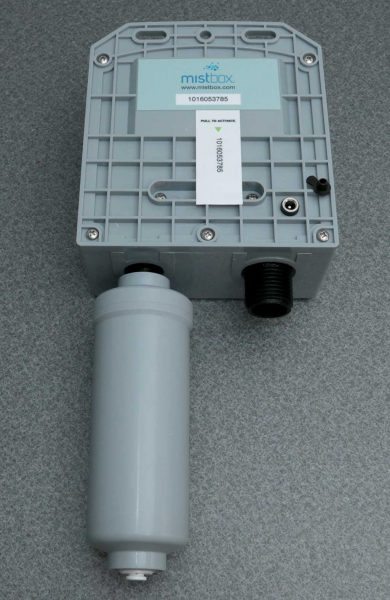
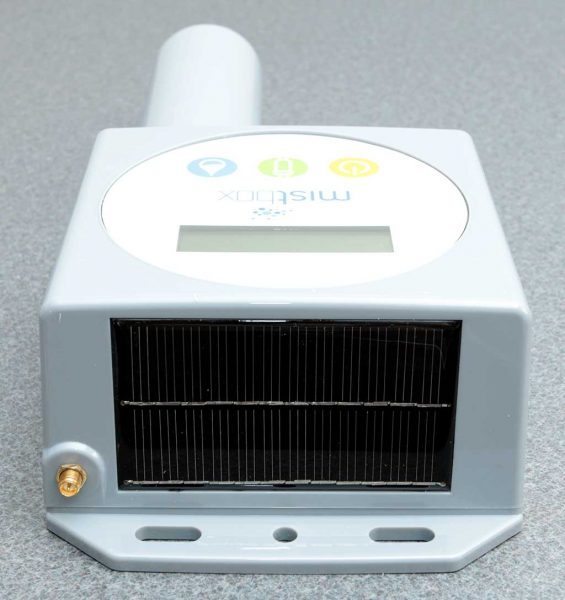
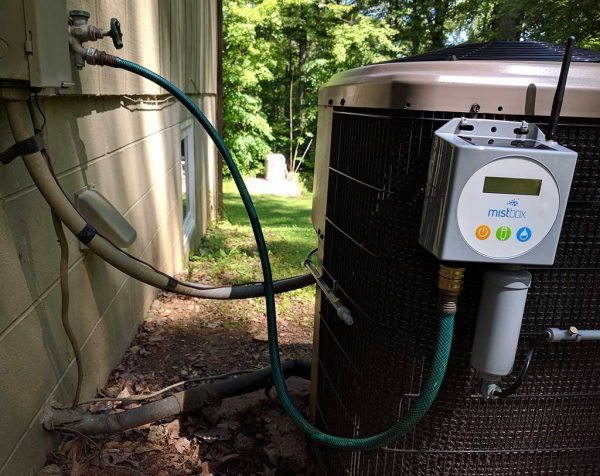
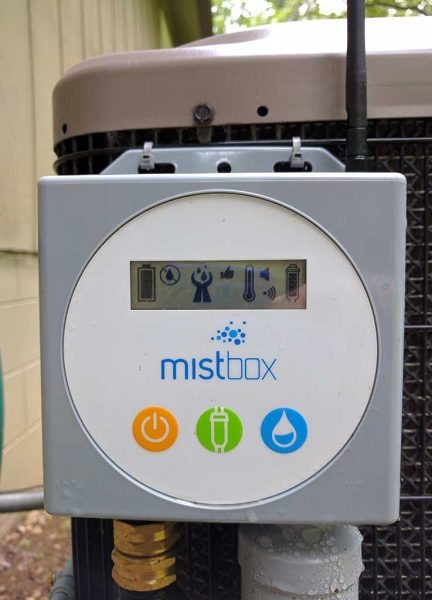
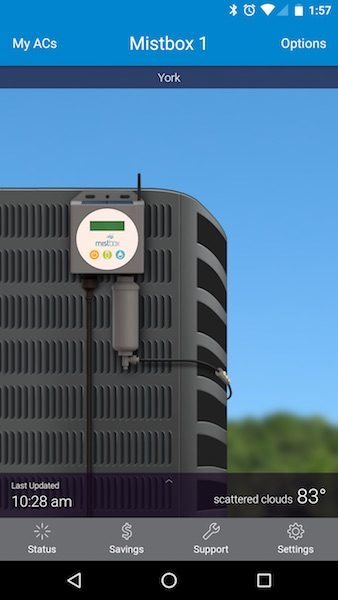
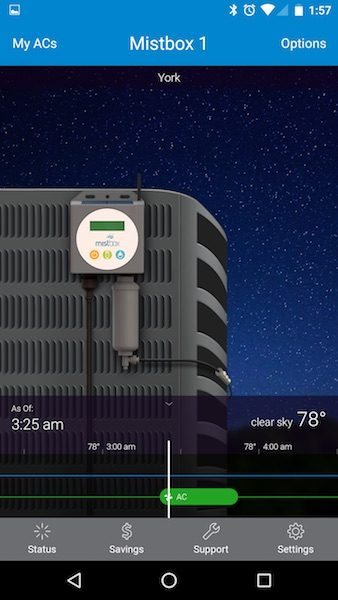
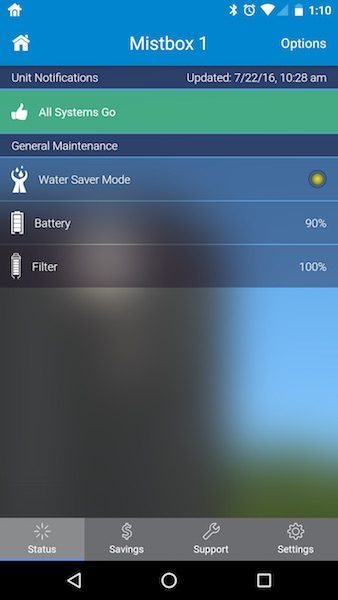
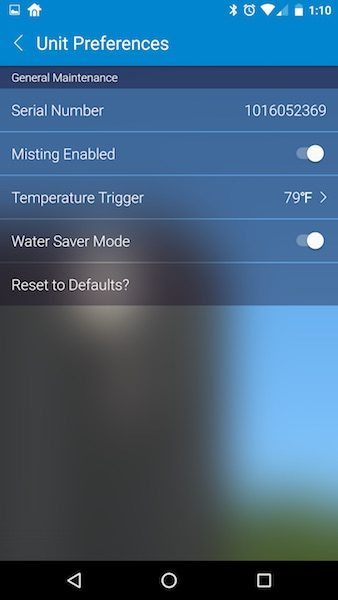


Gadgeteer Comment Policy - Please read before commenting
Interesting product! I’ve been waiting to hear your thoughts on it since it was teased a few weeks ago! (PS, the YouTube video is set to private.)
Argh! I hate when I forget to set to public. Fixed now. Thanks for letting me know 🙂
I agree with you about being concerned about that much water deposited next to your foundation – I’m getting about 3 gallons/day out of the condensation drain from my mini-split system which would drip right on the foundation if I wasn’t catching it to recycle (on non-food plants due to possible heavy metal contamination from the system).
At my base water rate (+sewer rate, which is calculated by water use, not actual sewer outflow) if this ran 12 hrs/day it would cost me $1.20/day. However, 9 days of use would equal 1 CCF of water (my rate unit of calculation), and a couple weeks of that would bump me into the next higher rate zone, so $1.30/day.
I set out 2 large sized Cool Whip style plastic containers to catch some of the water from 2 main drip points. I placed one container under the Mistbox filter and another at the end of the last spray bar. Each little “bucket” would be full or overflowing after 24hrs. My guess is that together the buckets add up to 1 gallon. I use the collected water to water Jeanne’s outside potted plants.
Very tempting, esp. since the air in my area is quite dry. It would work great. However, our water is really hard so we would quickly mineralize our AC unit and necessitate expensive maintenance. 🙁
The review does mention that it comes with a filter specifically to combat that.
Most filters are not able to filter out dissolved minerals. That’s why people use water softeners.
A lot of people in my neck of the woods put up a small table/tent structure over their AC units to keep the sunlight off of them. Doesn’t help with the outside air temp, but cuts the AC units temperature quite a bit.
Thanks for the review, I was really interested in it, and tried to do some research on it with very mixed reviews. I was very skeptical, and looks like it paid off. I also live in a very humid area (DC) and my A/C just broke. I do know the apartment building I was at would have a sprinkler going over their roof A/C systems which I was always wondering why they did it.
I have sen this product a couple of times and what would keep me from its purchase in the perfect place on Earth for this product, Fort Worth Texas, is that my condenser unit does not possess the protective grate to mount this cooling unit to. Then there is $400.00 dollar price tag. But I could overcome that portion of this issue but for the mounting issue.
It’s been a while since you have been using this product and I was wondering if you could give an update on the progress.
Have had any issues with deposits building up on the condensor?
I am very curious to know of any further benefits or issues pros/con you have experienced with this.
Thank you
john
I removed the unit shortly after the review because it was making the area around my AC muddy.
I got in on the Kickstarter for Mistbox, with the thought that if it works, great! If it doesn’t, I’ll survive. After all, every Kickstarter is a gamble. But this one paid off!
I live in Idaho, and we moved into our current home 3 years ago. The A/C unit here is about 20 years old and has a difficult time keeping up with the high temperatures in the summer. When the temps are in the 90’s, the A/C may start at 70 in the morning, but it will reach the high 80’s by late afternoon. NOT enjoyable at all! Our electricity bill (on “level-pay”) were just over $220 per month!
I installed Mistbox lats August 13th and since then, our A/C has no problem keeping the temperature down even on the hottest days. Our electricity bill (again, on “level pay”) has dropped to just over $150 per month! That’s a $70 per month decrease!
Now, I’m not going to say that the Mistbox is saving us over $800 per year. I don’t think it is. But I DO think that it is saving us at least $50 a month for June, July, and August, and $25 a month for April, May, September and October.
In addition, I think that it is extending the life of our A/C unit, as it doesn’t have to work nearly as hard, or as long, each day, just to keep the house cool.
If you live someplace hot, like Idaho, I’d say it’s well worth the money! I recommend it to all my friends, family, and even to handymen that have dropped by every so often.
If you live somewhere cooler, maybe it won’t be as useful. Or if you have a newer A/C unit. But, then, maybe it will extend the life of yours as well. I have no idea. But for me, anything that gives me a few more months/years before I have to spend $1,000+ to replace my A/C unit is a good thing right now.
Hawk, thank you for sharing your thoughts and experiences about this product!